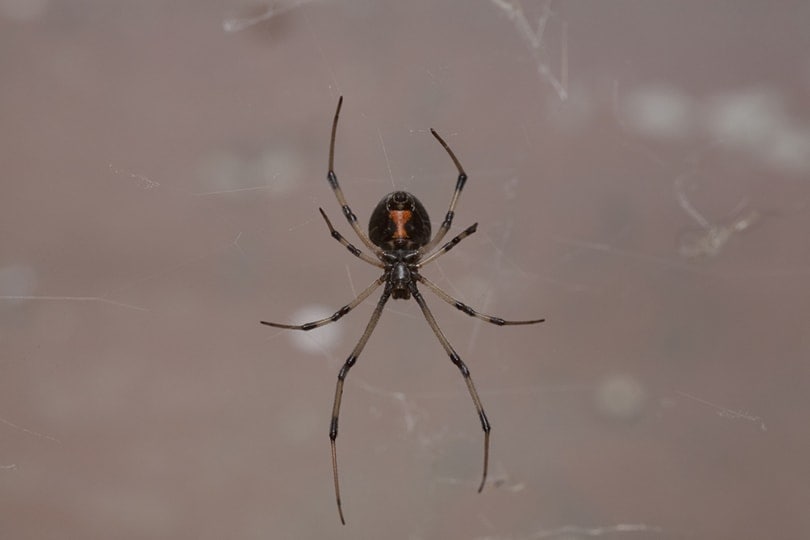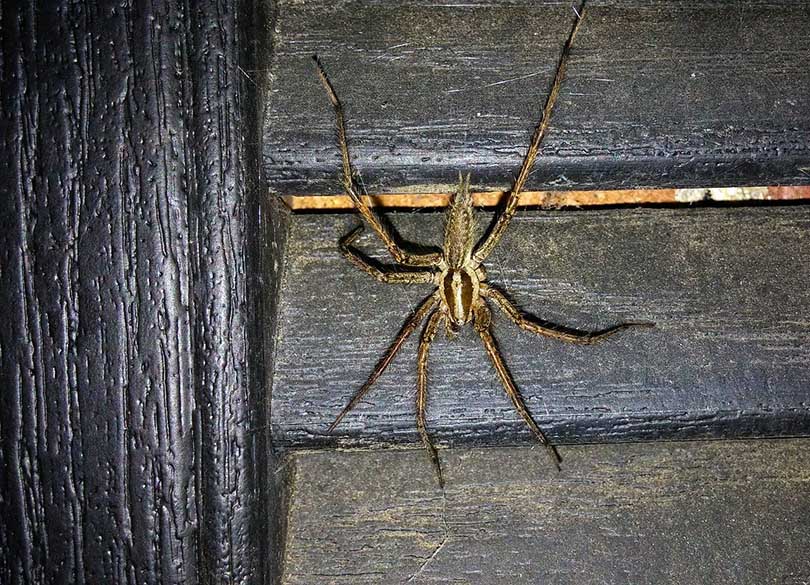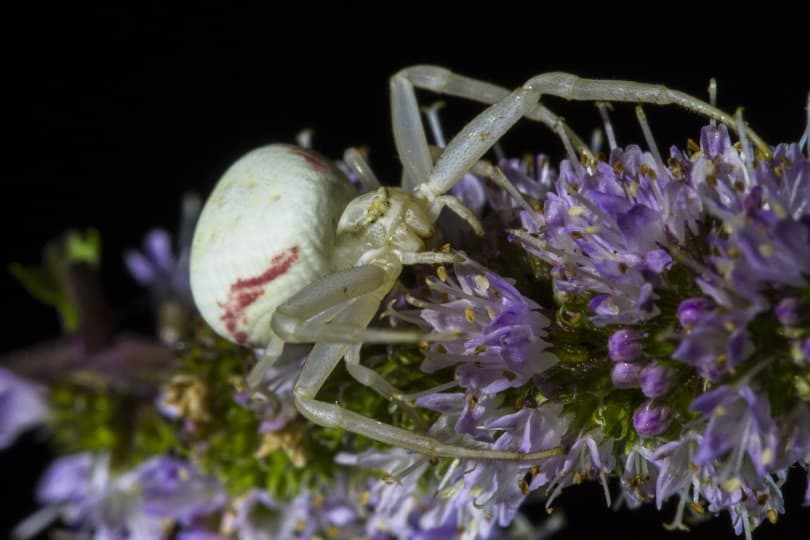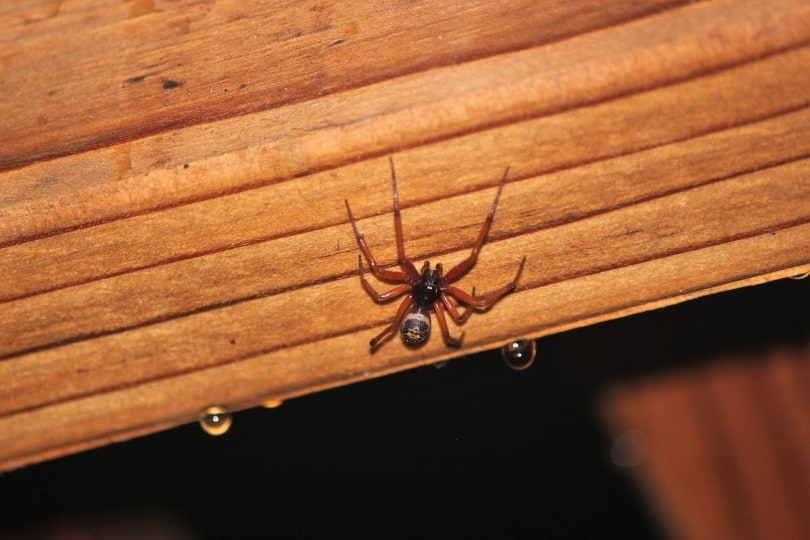Spiders are everywhere, including in your own backyard. So, when you see one, the question becomes: What kind of spider are they?
If you live in California, there’s a good chance that they’re on the list here. Different species will live in different locations, but the good news is that there are only a few spiders in the state that are dangerously poisonous to humans.

The 11 Spiders Found in California
1. Western Black Widow

| Species: | L. hesperus |
| Longevity: | 3 years |
| Good to own as a pet?: | No |
| Legal to own?: | No |
| Adult size: | 3–10 mm |
| Diet: | Carnivorous |
This is perhaps the most terrifying spider in the entire United States, not just California. Known for their jet-black bodies with the telltale red hourglass on the abdomen, western black widows are highly poisonous to humans, although death from a black widow bite is rare.
They like to hang out in woodpiles, attics, and in between boxes in storage spaces. They’re nearly blind, so they catch their prey through vibrations in their web; that means you probably won’t get bit as long as you don’t stumble through one of their webs.
Black widows eat all manner of insects, and they’re preyed on by birds, lizards, and in the case of male black widows, female black widows.
2. California Tarantula
| Species: | A. iodius |
| Longevity: | 8 years |
| Good to own as a pet?: | Yes |
| Legal to own?: | Yes |
| Adult size: | 4–6 inches |
| Diet: | Carnivorous |
Tarantulas are as notorious as black widows, but they’re not nearly as harmful to humans. Their bites may be painful, but they won’t kill you, which is why they’re so popular as pets.
They eat all sorts of things, including bugs, lizards, scorpions, other spiders, and even small snakes. They also have a surprising number of predators, including wasps, birds, and even coyotes.
There are actually several different species of tarantula in California, including the “Johnny Cash Tarantula” (so named because it was discovered near Folsom Prison). They can be found in massive numbers at certain times of the year, as they actually migrate in certain months.
3. American Grass Spider

| Species: | A. actuosa |
| Longevity: | 2 years |
| Good to own as a pet?: | No |
| Legal to own?: | Yes |
| Adult size: | 10–20 mm |
| Diet: | Carnivorous |
If you’ve ever set foot on a lawn in California, then you’ve almost certainly been close to an American Grass Spider. Like tarantulas, there are multiple species in California, although most are yellowish-brown with stripes on their back.
Unlike wolf spiders, with which they’re commonly confused, these spiders build funnel webs near the ground. Small bugs or other spiders wander in, and then they can’t get out. Their predators include birds, lizards, and of course, other spiders.
Their bites aren’t necessarily dangerous to humans; in fact, their tiny little teeth have difficulty piercing our skin. If they do penetrate your skin, though, the bites can be dangerous — not because of the venom, but because they can lead to bacterial infections.
4. Black and Yellow Garden Spiders

| Species: | A. aurantia |
| Longevity: | 1 years |
| Good to own as a pet?: | No |
| Legal to own?: | Yes |
| Adult size: | 10–25 mm |
| Diet: | Carnivorous |
These spiders can be found in gardens all across the United States, and they’re just as common in California as anywhere else. They go by all sorts of different names, including zipper spiders and banana spiders.
They can spin massive webs for snaring all sorts of flying creatures, and they usually sit smack dab in the middle of them, so if you walk through one of their webs, you might get one of them in your hair. Birds, lizards, and some wasps will eat them if they get the chance.
They have oval-shaped bodies with extremely long legs, often with black-and-yellow coloring.
5. Fishing Spider

| Species: | D. vittatus |
| Longevity: | 2 years |
| Good to own as a pet?: | No |
| Legal to own?: | Yes |
| Adult size: | 50–75 mm |
| Diet: | Carnivorous |
These spiders are unnervingly large, and as you might expect, they like to hang out near the water. While they have been seen eating small fish, they primarily eat little aquatic insects. Many will just stand on the surface of the water, as they’re not heavy enough to break the surface tension.
These spiders are dazzlingly fast. If you see one (they like to hide in boat houses or near the edge of the water), they’ll usually run away in the blink of an eye. They’re not that aggressive and their bites aren’t dangerous.
There are various fishing spiders in California, but the most common is black with a white rim around the abdomen.
6. Flower Crab Spider

| Species: | M. fidelis |
| Longevity: | 2 years |
| Good to own as a pet?: | No |
| Legal to own?: | Yes |
| Adult size: | 6–16 mm |
| Diet: | Carnivorous |
If you’ve ever leaned in to get a whiff of a rose, only to find yourself face-to-face with a tiny spider, then congratulations, you’ve met a flower crab spider. This is a genus of spiders, with multiple species, all of which are fairly common.
They’re usually white or yellow, but their bodies will usually match the color of the flower in which they’ve taken up residence. They lie in wait inside flowers for bees, butterflies, moths, and similar insects to come along, at which point, they’ll snatch them out of the air for a snack. They have a fair amount of predators to worry about too, including birds, ants, wasps, and bigger spiders.
These spiders are timid, not dangerous to people, and kind of cute, at least as far as spiders go.
7. Hobo Spider

| Species: | E. agrestis |
| Longevity: | 1 year |
| Good to own as a pet?: | No |
| Legal to own?: | Yes |
| Adult size: | 10–15 mm |
| Diet: | Carnivorous |
Hobo spiders are commonly confused with American Grass Spiders. Like those other spiders, they spin little funnel webs on the ground and wait for unfortunate bugs to stumble into them.
These brown spiders have dark chevrons on their abdomens, usually pointing toward the spider’s head. They usually hang out in lawns and other fields, preferring to avoid human habitats. They don’t do this to be polite, but rather because your house is usually home to larger spiders that will eat this one.
Hobo spiders were long thought to be incredibly dangerous, but there’s no evidence that their bites pose a threat to humans. Instead of munching on people, they prefer to eat beetles, ants, and other small insects, while they’re often eaten by birds, centipedes, and wasps.
8. Spinybacked Orb Weaver

| Species: | G. cancriformis |
| Longevity: | 1 year |
| Good to own as a pet?: | No |
| Legal to own?: | Yes |
| Adult size: | 5–9 mm |
| Diet: | Carnivorous |
These tiny, odd-looking spiders resemble something that Super Mario would have to jump on during his quest to save Princess Peach, but they’re quite harmless to humans. You’ll find several spines on their sides, and their backs are quite colorful — usually a mix of black, white, and yellow. However, there are quite a few different species of Spinybacked Orb Weavers, all of which can come in different colors.
They can be found all over the United States, and despite their diminutive size, they’re capable of spinning truly majestic webs (which they eat and rebuild every day). They like to build those webs in forests and other tree-heavy areas, so you may find them in your backyard if you have plenty of shade there.
Like most of the spiders on this list, they eat insects that are smaller than they are, while falling victim to wasps, birds, and other spiders.
9. Hacklemesh Weaver
| Species: | M. simoni |
| Longevity: | 2 years |
| Good to own as a pet?: | No |
| Legal to own?: | Yes |
| Adult size: | 8–9 mm |
| Diet: | Carnivorous |
The Hacklemesh Weaver was actually introduced to the United States from Australia, but despite their terrifying origins, this is not one of those Australian spiders that can kill you just by looking at you. On the contrary, these docile creatures have to really be provoked to attack, and even then, their bite is harmless (provided that they can break the skin at all).
They have brown, shiny upper bodies with black, hairy abdomens, and the area around the eyes and mouth is black. They’re often mistaken for brown recluses.
These spiders spin erratic webs, so don’t expect them to give Charlotte a run for her money. They catch small insects and sometimes get caught by birds and larger bugs, just like other spiders.
10. Brown Widow

| Species: | L. geometricus |
| Longevity: | 2 years |
| Good to own as a pet?: | No |
| Legal to own?: | No |
| Adult size: | 10–15 mm |
| Diet: | Carnivorous |
This spider has become so invasive in parts of California that it’s actually pushing the deadly black widow out of their natural habitat. They love to hide in dark places, like the handles of garbage cans and buckets in your garage.
It appears that the brown widow’s venom is just as toxic as their more infamous cousin’s, but that doesn’t mean they’re dangerous to humans. People who’ve been bitten by brown widows haven’t exhibited any symptoms worse than minor swelling and redness, possibly because these spiders lack the same amount of venom that makes black widows so dangerous.
Their body structure resembles that of the black widow, although they have mottled brown bodies and striped legs. The hourglass on their back is orange rather than red. Of course, in the heat of the moment, it’s hard to tell a black widow from a brown one, and we don’t recommend getting close enough to introduce yourself.
11. Spitting Spider
| Species: | S. thoracica |
| Longevity: | 2 years |
| Good to own as a pet?: | No |
| Legal to own?: | Yes |
| Adult size: | 4–6 mm |
| Diet: | Carnivorous |
These spiders can actually spit silk at their victims (usually ants, beetles, and other walking insects), pinning them to the ground so they can finish them off in peace. Fortunately, they’re not likely to be able to pin you to the ground, nor will they waste their silk by shooting it at you. Even if they bite you, their bites are largely harmless.
Their bodies are light brown with dark spots, and their cephalothorax (the front part of their body) is larger than their abdomen. They also only have six eyes rather than eight, which is a fact that likely won’t help you identify them, but at least it gives you a nice icebreaker at parties.

Conclusion
There are hundreds of different spider species in California, but the 11 on this list represent some of the ones that you’re most likely to encounter. Most of them are completely harmless, so there’s no reason to worry if you see one.
You may also like:
- How Do Spiders Find and Communicate with Each Other?
- 6 Spider Species Found in Washington (with Pictures)
- 12 Spiders Found in Missouri (With Pictures)
Featured Image Credit by Piqsels
